
Best Website for Herkimer Diamond Information
Last Updated:

About this Webpage:


Free Website Where Herkimer Diamond Enthusiasts Share Information with the Public
Scroll down
Dr.C. did two talks at the Herkimer Diamond Festival (July)which are in a Youtube movie. The research on the Herkimer District is in need of samples and photos.
How can you help? Visit the "how to help" page.

Hopper and Skeletal crystals - beautiful patterns
and a story to tell.
The Herkimer district produces both skeletal and hopper quartz crystals. The proesses that produce them are connected to super saturated fluids, an important part of the history of Herkimer diamonds. These types of crystals are not as common as the normal Herkimer diamonds and there is a common name "elestial" that is sometimes used. Skeletal and hopper crystals have something in common, they both show step-like patterns that mimic the edges and faces of the crystal. The difference is that the skeletal have these features mostly on the inside of the crystal, like a skeleton. The hopper crystals show this step-like pattern mostly on the outside. Examples below.


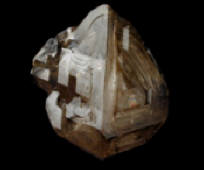




Skeletal and Hopper Crystals

Textures on Skeletal and Hopper Crystals
W. David Hoisington, Ph.D.

On the left (from the NYSM collection) is an excellent picture of a skeletal crystal where you can see the concentric lines mimicing the edges of the crystal face, yet hidden under a flat smooth clear surface. There is also a small hole where the flat face did not completely heal over. One of the reasons that these skeletal features can be seen well in this crystal is that they have a cream/tan clay coating on some of the skeletal features (see photos below). A close up is shown below note how the interior features mimic the exterior form of the crystal.



Hopper Crystals

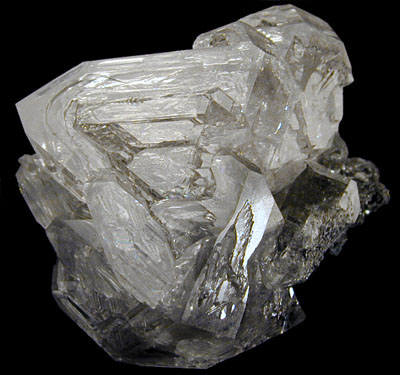
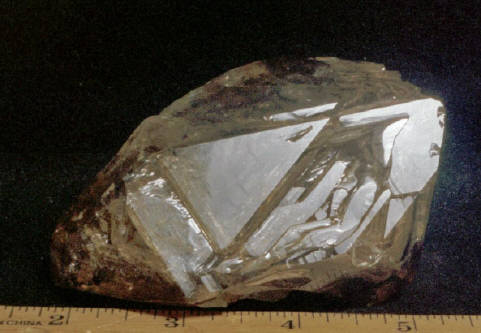
Hopper crystals from the Herkimer mining district almost alway have some interesting testures or patterns somewhere on the crystal. The above photos show the most common feature - the step like pattern down the face of the crystal, toward the middle.
Below (left) is a regular camera photo from the above hopper crystal showing "pine tree" melting/healing texture textures, sort of what it looks like to the naked eye. Second to the step like pattern the "pine tree" texture is the most common texture seen associated with skeletal and hopper crystals. Below right is a microsope photo of "pine tree texture.
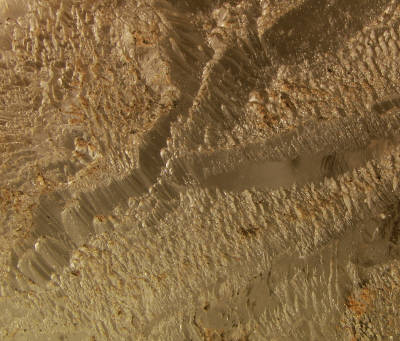
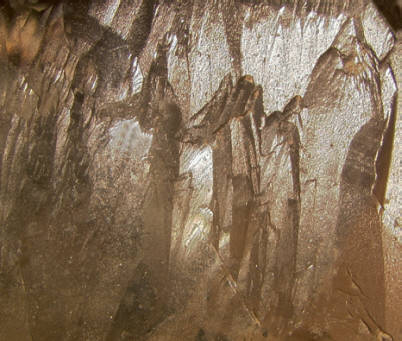
After the step pattern (which can be seen in the photo on the left as big arched steps on the lower left and also a series of lines in the upper right) and the "pine tree" texture (shown in the above photos), the third most common associated with hopper crystals is "scalloped etching".
The photo, taken with a macro lens, is 4 cm across and from TCR (donated by the mine owner). Arrow points to the scalloped etching. Photo Dr.C., 2010.
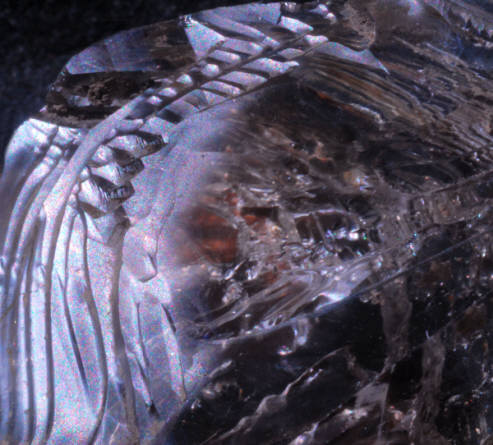

Other Skeletal and Hopper Crystal Features


Conclusions

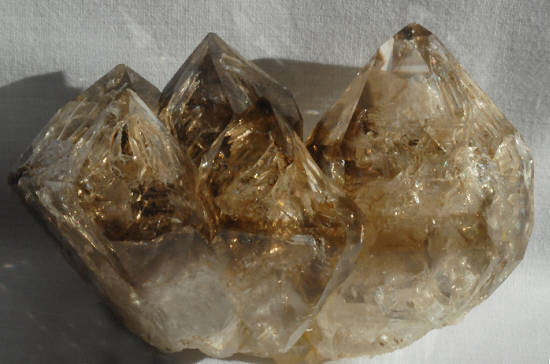
Some specimens from TCR have a combination of both the parallel growth and the gemmy step pattern with a smoky color. This results in specimens of unique attractiveness.
One photo of this unique type of specimen is shown below, from the mine owner's collection. Note the sharp face development, the gem clarity, and the smoky color. Specimen is 12 cm across. Photo Dr.C. 2010.
Large parallel growth clusters of Herkimer diamonds are rare.
Thus far, every deposit in the Herkimer mining district has either skeletal or hopper crystals, or both. This means that the conditions for making such crystals is a feature consistant across the district, in the same way the the black hydrocarbon and baby floater phase are consistent across the district. These consistent features are evidence related to the oil migragtion and seed crystal theory explaining the development of Herkimer diamonds.
The best way to think about hopper/skeletal crystals is to think about crystals being "forced" to grow very rapidly. This can happen when the solution is supersaturated, meaning it has alot of quartz disolved in it. What then happens is that the edges of the crystals grow faster then the faces, giving you this step like "skeleton". But the solution is not continually stable so we get face development alternating with edge development and sometimes the face development wins and the outside of the crystal is formed over the top of an "inside skelton". This fluctuating, unstable, nature of the fluid is also important in terms of understanding how clear Herkimer diamonds happen (see the FAQ) page. There was a dynamic interplay in the Herkimer district between the following conditions: 1) the saturation of the mineral forming solutions, 2) the seed crystal available, 3) the space available to grow, and 3) the amount of oil/gas present and its timing in connection to the Herkimer mineral bearing fluids.
We also know from field evidence that there was a late Herkimer "healing" quartz event (see the healing page). Some of the skeletal crystal features may be the result of this process (a hopper crystal that was healed), but there is still more research that needs to be done. 2009 field work at TCR suggests that when the later quartz healing event encountered a hopper crystal that it tended to form multiple parallel growth crystals over the earlier hopper as the solution struggled to decide which surfaces to actually grow from. A photo of this "skeletal/hopper parallel growth" is shown above.
More research needs to be done on hopper and skeletal crystals on the Herkimer district - donation of samples are welcomed.
July, 2011
